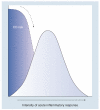Crohn's disease as an immunodeficiency
- PMID: 20594132
- PMCID: PMC4618314
- DOI: 10.1586/eci.10.32
Crohn's disease as an immunodeficiency
Abstract
The pathogenesis of Crohn's disease (CD) has widely been regarded as the consequence of a dysregulated T-cell-mediated response to intestinal microbes, and the majority of the worldwide research effort has focused on characterizing and treating the chronic inflammatory phase of the disease. However, recent molecular biological and clinical investigations indicate that CD is actually a primary immunodeficiency. At first counter-intuitive, the apparent paradox of a pathogenic innate immune defect can be linked mechanistically to the granulomatous chronic inflammation characteristic of the disease. Genome-wide association studies have corroborated the involvement of innate immune dysfunction in the pathogenesis of CD, but less than 20% of the heritable risk is accounted for. By contrast, in vitro and in vivo stimulation of the immune system has highlighted novel areas of interest that may lead to the development of targeted therapeutic and diagnostic tools.
Figures


Similar articles
-
Crohn's disease: an immune deficiency state.Clin Rev Allergy Immunol. 2010 Feb;38(1):20-31. doi: 10.1007/s12016-009-8133-2. Clin Rev Allergy Immunol. 2010. PMID: 19437144 Free PMC article. Review.
-
Crohn's as an immune deficiency: from apparent paradox to evolving paradigm.Expert Rev Clin Immunol. 2013 Jan;9(1):17-30. doi: 10.1586/eci.12.87. Expert Rev Clin Immunol. 2013. PMID: 23256761 Review.
-
Crohn's disease as an immune deficiency?Lancet. 2009 Sep 5;374(9692):769-70. doi: 10.1016/S0140-6736(09)61576-2. Lancet. 2009. PMID: 19733770 No abstract available.
-
The immunopathogenesis of Crohn's disease: a three-stage model.Curr Opin Immunol. 2009 Oct;21(5):506-13. doi: 10.1016/j.coi.2009.06.003. Epub 2009 Aug 8. Curr Opin Immunol. 2009. PMID: 19665880 Free PMC article. Review.
-
Defective innate immunity in inflammatory bowel disease: a Crohn's disease exclusivity?Curr Opin Gastroenterol. 2011 Jul;27(4):328-34. doi: 10.1097/MOG.0b013e3283463b45. Curr Opin Gastroenterol. 2011. PMID: 21483259 Review.
Cited by
-
Systems Pharmacological Approach of Pulsatillae Radix on Treating Crohn's Disease.Evid Based Complement Alternat Med. 2017;2017:4198035. doi: 10.1155/2017/4198035. Epub 2017 Jun 1. Evid Based Complement Alternat Med. 2017. PMID: 28659988 Free PMC article.
-
Successful treatment of asymptomatic or clinically terminal bovine Mycobacterium avium subspecies paratuberculosis infection (Johne's disease) with the bacterium Dietzia used as a probiotic alone or in combination with dexamethasone: Adaption to chronic human diarrheal diseases.Virulence. 2011 Mar-Apr;2(2):131-43. doi: 10.4161/viru.2.2.15647. Epub 2011 Mar 1. Virulence. 2011. PMID: 21460639 Free PMC article. Clinical Trial.
-
The Drosophila CD36 Homologue croquemort Is Required to Maintain Immune and Gut Homeostasis during Development and Aging.PLoS Pathog. 2016 Oct 25;12(10):e1005961. doi: 10.1371/journal.ppat.1005961. eCollection 2016 Oct. PLoS Pathog. 2016. PMID: 27780230 Free PMC article.
-
Dietary Fiber Intake is Associated with Increased Colonic Mucosal GPR43+ Polymorphonuclear Infiltration in Active Crohn's Disease.Nutrients. 2015 Jul 1;7(7):5327-46. doi: 10.3390/nu7075223. Nutrients. 2015. PMID: 26140540 Free PMC article.
-
Intestinal dendritic cell and macrophage subsets: Tipping the balance to Crohn's disease?Eur J Microbiol Immunol (Bp). 2011 Mar;1(1):19-24. doi: 10.1556/EuJMI.1.2011.1.5. Eur J Microbiol Immunol (Bp). 2011. PMID: 24466433 Free PMC article. Review.
References
-
- Rogler G, Andus T. Cytokines in inflammatory bowel disease. World J. Surg. 1998;22(4):382–389. - PubMed
-
- Hanauer SB. Inflammatory bowel disease: epidemiology, pathogenesis, and therapeutic opportunities. Inflamm. Bowel. Dis. 2006;12(Suppl. 1):S3–S9. - PubMed
-
- Brand S. Crohn’s disease: Th1, Th17 or both? The change of a paradigm: new immunological and genetic insights implicate Th17 cells in the pathogenesis of Crohn’s disease. Gut. 2009;58(8):1152–1167. - PubMed
-
- Neurath MF. IL-23: a master regulator in Crohn disease. Nat. Med. 2007;13(1):26–28. - PubMed
Publication types
MeSH terms
Grants and funding
LinkOut - more resources
Full Text Sources
Medical
Molecular Biology Databases
